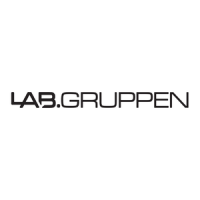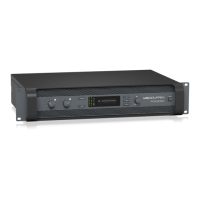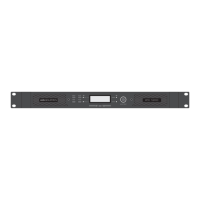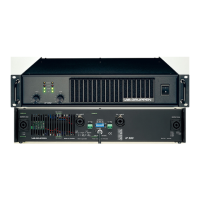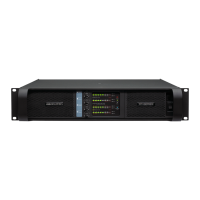5. Introduction
7
D SERIES Lake Operation Manual rev 3.0.4
5. Introduction
6
D SERIES Lake Operation Manual rev 3.0.3
5. Introduction
5.1. Welcome
Thank you for choosing the Lab.gruppen D Series for your sound
offered by this product.
For fast installation and use of this product, your welcome package includes a printed copy of the D Series
Quick Start Guide (QSG). It provides a brief introduction to the features and functionality of the D Series and it
also contains the information required to safely install the product and place it in service. Please read through
recommended that you also review all other product documentation to ensure familiarity with the various
5.2. D Series: Two versions available
This operation manual is for use with Lake processing versions only, and applies to models at all six output
power levels. The models D 200:4L, D 120:4L, D 80:4L, D 40:4L, D 20:4L and D 10:4L will further on only
be referred to as D200, D120, D80, D40, D20 and D10.
D Series is an advanced, high–power installation amplifier platform designed for demanding applications, primarily
in performance venues. For the utmost flexibility in processing and networking, the D Series is available in two
versions: the Lake version, with a full slate of Lake processing algorithms, Dante and AES67 audio networking;
and the Tesira by Biamp version for full integration in a Tesira system and with Ethernet AVB audio transport.
D-series Tesira versions are available in three output power levels, whereas the D-series lake versions are available
in six output models. The six Lake power output models come in two form factors. Three high power models in a
standard form factor and three lower powered models in a slimline, single rack unit, form factor.
5. Introduction
D SERIES Lake Operation Manual rev 3.0.3
7
5.3. Feature summary
5.3.1. Features common to both D Series variants
• Four channels with six levels of total available frame power output: 20000 W, 12000 W, 8000 W, 4000 W,
2000 W and 1000 W
• Rational Power Management (RPM)
• True exibility in allocating power output across each channel to match requirements, for more efcient
use of amplier inventory
• Any channel is capable of being signicantly scaled up to match power requirements.
• Dedicated on–board surveillance and load monitoring for voice alarm applications
• Advanced universal power supply
• Regulated Switch–Mode Power Supply (R.SMPS™) maintains stability through uctuations in mains voltage
• Best–in–class Power Factor Correction (PFC)
• Current Draw Modeling (CDM™) reduces peak mains draw
• Breaker Emulation Limiter (BEL™) responds to available mains distribution
• Under–Voltage Limiting (UVL™) allows continued operation through mains voltage drop
• CAFÉ (Conguring Ampliers For the Environment) software incorporates ESP™ (Equipment Specication
Predictor) to assist in design, equipment specication and commissioning
• Features controlled by on–board DSP
• Amplier gain is set in the digital domain and controlled via the Lake Controller software.
• ISVPL™ – The Inter–Sample Voltage Peak Limiter (ISVPL) tailors each channel’s power output to the
characteristics of the connected load
• Load Verication & Performance Monitoring – A comprehensive set of proprietary DSP–based tools
enables load verication and real–time performance monitoring
NOTE: The D200, D120 and D80 models have the possibility to bridge two power outputs to further
increase scalability. This feature is not available on the D40, D20 and D10 models.
5.3.2. Features unique to Lake variant
• Lake’s exclusive classic/linear–phase/FIR speaker processing platform with four throughputs
• Group control with Raised Cosine™ MESA EQ™ asymmetric lters
• LimiterMax™ peak and RMS limiters
• Extensive loudspeaker preset database (Lake LoadLibrary™)
• Comprehensive clocking management system with low latency sample rate conversion
• Full support for Dante Controller
• Multiple and redundant inputs with programmable failover
• Four “Lake Class” analog inputs with Iso–Float™ ground isolation
• Two AES3 digital inputs (4 audio channels)
• Eight dual–redundant Dante network audio inputs with AES67 support
• Comprehensive 3rd party protocol for integration potential with third party matrix systems via purpose–
developed middleware

